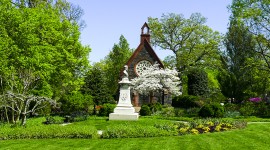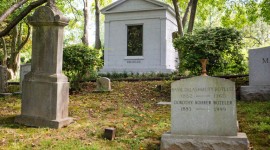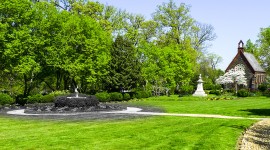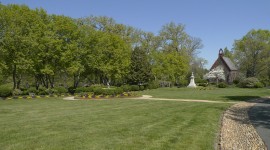Oak Hill Cemetery Is Threatened by a Regulatory Gap
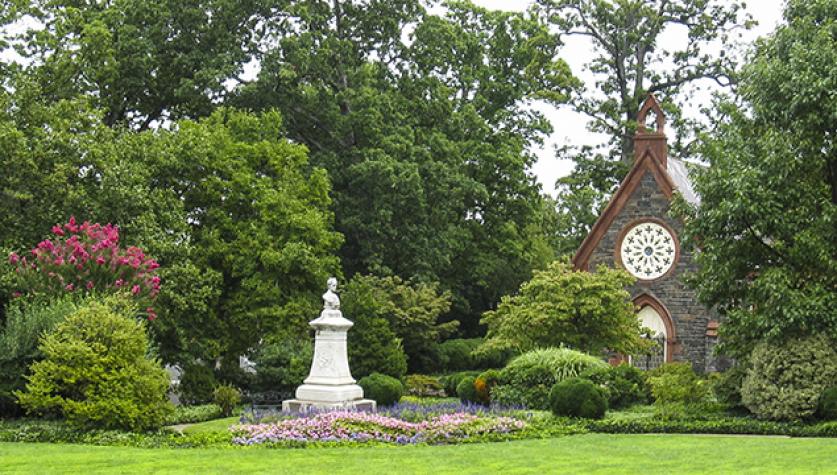
Located within the Georgetown Historic District in Washington, D.C., Oak Hill Cemetery was the city's first designed rural cemetery. The site's entrance ensemble, largely unchanged since the 1880s, is comprised of the Ellipse, an oval lawn that connects the cemetery's gatehouse both visually and spatially to the iconic Renwick Chapel (the entrance ensemble is equivalent to the primary facade of a historic building). A new mausoleum, for which no construction permit was requested, has been built on the Ellipse, significantly compromising the site's integrity. On Wednesday, October 21, 2015, the District of Columbia's Department of Consumer and Regulatory Affairs determined that a building permit is required, which means various regulatory agencies including the D.C. Historic Preservation Review Board and the U.S. Commission of Fine Arts would now be able to determine whether the new mausoleum is appropriate and any remediation that might be required.
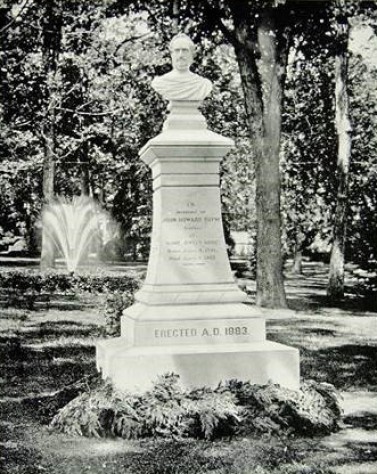
History
The cemetery was chartered by Congress in March 1848, and was laid out on 12.5 acres that local banking magnate and philanthropist William W. Corcoran donated for that purpose in May 1849. One year later, the iconic English Gothic chapel designed by James Renwick (listed in the National Register of Historic Places in 1972) was built within the cemetery, and, by 1853, the cemetery’s gatehouse was constructed west of the chapel. Between the gatehouse and the chapel, a roughly oval and flat expanse of land was circumscribed by a pathway. Now known as the Ellipse, the area appears on an early plan of the cemetery in a form identical to its current footprint. It is thus clear that the Ellipse was planned as an integral part of the cemetery’s entrance ensemble, connecting the gatehouse with the chapel both visually and spatially while overlooking the terraced acreage that falls away to the bed of Rock Creek on the northern edge of the site. The plan of the cemetery is attributed to George de la Roche, although some have suggested, based on circumstantial evidence, that Andrew Jackson Downing played a role in its creation.
Expanses of lawn like the Ellipse were often found in rural cemeteries of the era, of which Oak Hill was the first in Washington, D.C., and was among the earliest anywhere. The nation’s first designed rural cemetery was Mount Auburn Cemetery, established in 1831 in Cambridge, Massachusetts (declared a National Historic Landmark in 2003). The similarities between Oak Hill and Mount Auburn have been noted by historians, perhaps most recently and substantively in a 1995 article in Smithsonian Preservation Quarterly.
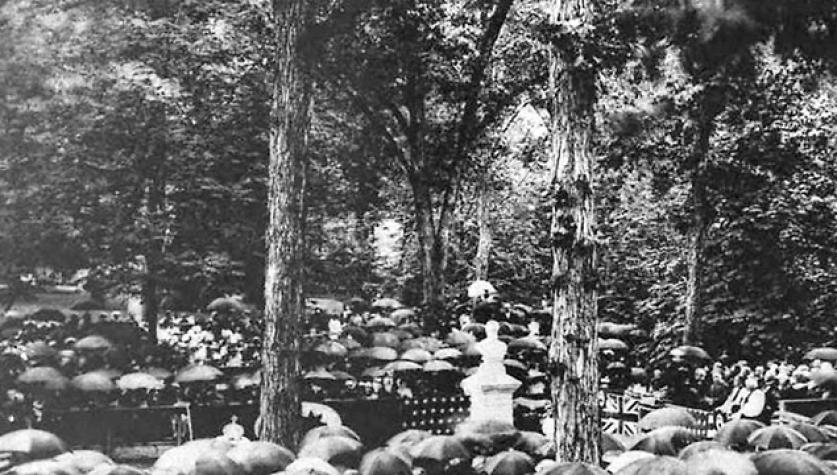
In the years after the cemetery’s founding, the Ellipse at Oak Hill would only gain in importance and historical significance. In 1883, Corcoran arranged for the remains of John Howard Payne, the American poet and consul of the United Sates, whom he personally knew and admired, and who had been buried in Tunis, to be brought for re-interment at Oak Hill. On June 9, 1883, a marble monument with a portrait bust of Payne was unveiled on the eastern part of the Ellipse, with President Chester A. Arthur and members of his Cabinet and of the Supreme Court in attendance. A small circular fountain with a spray jet had also been installed near the middle of the Ellipse by then, for an account of the day’s events in an 1883 periodical recalls that Payne’s monument occupied a place “between the chapel and the fountain…on the crest of a hill, which slopes down into the valley of Rock Creek.” A photograph taken in 1894 shows the monument and the fountain quite clearly, with occasional trees still dappling the lawn.
Presiding over the re-interment that day was another of Corcoran’s friends, Bishop William Pinkney, whose body, as fate would have it, would be brought to Oak Hill for burial fewer than thirty days later. Corcoran then commissioned a monument for Pinkney from sculptor Alexander Doyle (who had made the monument for Payne) and installed it “upon the lawn near the entrance; a section not appropriated for burial purposes, and opposite the J.H. Payne monument,” as the bishop’s 1890 biography by Orlando Hutton reported.
Separated by a circular fountain (which was later exchanged for one with an avian motif) the Payne and Pinkney sculptures formed an east-west axis with the entrance of the iconic Renwick Chapel; the trio of monuments is mentioned in several early-twentieth-century travel guides, including Rand, McNally & Co.’s Pictorial Guide to Washington, D.C. (1901) and Rider’s Washington: Guide Book for Travelers (1924). Installed by the cemetery’s founder in 1883, the Payne and Pinkney monuments have thus been in an uninterrupted historical dialogue for over 130 years, anchoring the Ellipse as the only funerary monuments so honored by their presence upon it.
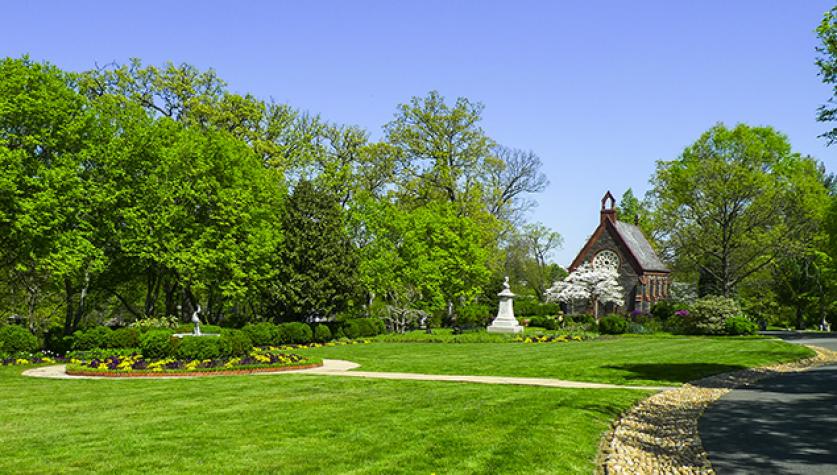
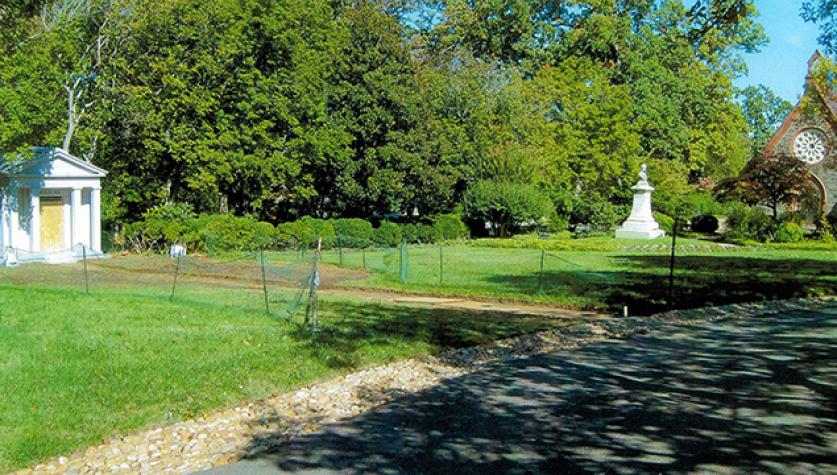
Threat
In summer 2015, a mausoleum was erected to house the remains of legendary Washington Post editor Ben Bradlee on the north side of the Ellipse, displacing the central fountain and its associated circulation route. According to Politico, Bradlee's family had purchased another site in the cemetery ten years earlier, but more recently, cemetery officials sent his widow, Sally Quinn, "a letter, noting new, larger spots were open and for sale," and "Quinn pounced at the opportunity to create a much grander final resting place."
Clearly visible from R Street, the new mausoleum faces south onto the open lawn and establishes a new perpendicular axis from its prominent central position. It has thus disrupted the cemetery’s historic entrance ensemble, thereby diminishing the integrity of the setting of the Renwick Chapel, the gatehouse, and the Ellipse of Oak Hill Cemetery. The mausoleum also adversely impacts the scenic views once afforded from the elevated plateau into the terraced grounds below.
This is a surprising development because it has occurred within the Georgetown Historic District, which is subject to oversight by many organizations, including the D.C. Historic Preservation Review Board, the U.S. Commission of Fine Arts, and the Old Georgetown Board (Stephen Muse, the chair of the Old Georgetown Board, is the project’s architect). However, a construction permit, which would have triggered a review by one or more of these organizations, was never requested, and there was no oversight. Now that the D.C. Department of Consumer and Regulatory Affairs has determined a construction permit was required, those entities will be able to examine the matter.
TCLF also suggests that a Cultural Landscape Report (CLR) be done to help in the future management of this nationally important landscape, and to form the foundation for any application for listing the cemetery in the National Register of Historic Places and designating it as a National Historic Landmark. In addition, the policies for reviewing such construction should be re-examined and clarified so that historic designed landscapes such as Oak Hill Cemetery can be protected.
How You Can Help
Contact the following individuals and institutions and urge them to find a solution that preserves the integrity of this nationally significant cultural landscape:
Thomas Luebke, Secretary of the U.S. Commission of Fine Arts and the Old Georgetown Board:
U.S. Commission of Fine Arts
401 F Street, NW, Suite 312
Washington, DC 20001
Gretchen Pfaehler, AIA, Chair of the D.C. Historic Preservation Review Board:
D.C. Historic Preservation Review Board
1100 4th Street, SW, Suite 650 East,
Washington, DC 20024




